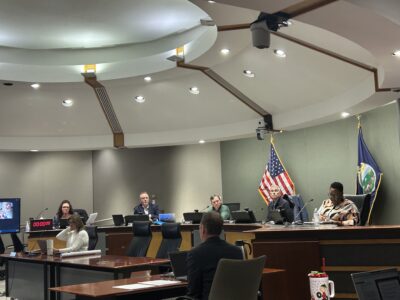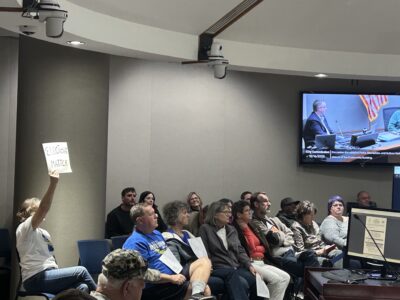Autistic children might find their ‘voice’ with KU project

Eleven-year-old Tait Holter uses what his mother, Maria, refers to as a “pod” to communicate that he would like help finding a lost object in his Lawrence home. Tait, who is autistic, uses various forms of technology to assist with communication. By pressing a combination of keys and icons, Tait can express his feelings and desires with the device, which will articulate the command. Maria and Mark Holter, pictured Friday, are applying to have Tait enrolled in a program at Kansas University that will pair graduate students in speech-language pathology with individuals who use communication devices.

A screen shows numbers with accompanying sign-language symbols on Tait’s “pod.”
Eleven-year-old Tait Holter pushes a button that has a picture of a heart on a hand-held device. It has the word “love” underneath.
“I love you,” a voice says when pushed.
The device serves as Tait’s voice, and he uses it to tell his parents, Mark and Maria Holter, that he loves them.
The technology helps the Lawrence boy who has autism, a complex developmental disability that causes problems with social interaction and communication. About one in every 150 children in the United States has autism, according to the Centers for Disease Control and Prevention.
The Holters are applying to participate in a new Kansas University project that could help improve Tait’s communication skills. The project begins in August.
“Our son has traveled through many different ways of communicating,” Maria said.
At age 2, a speech therapist began using pictures to communicate with Tait and he quickly caught on.
“What we’ve always known with Tait is that he wants to communicate. He just can’t use his mouth, so he started using pictures to talk,” Maria said. “But, of course, there obviously were limitations. You know, how many pictures can you have?”
At age 3, they introduced him to sign language, which had a couple of benefits. First, it didn’t limit his vocabulary, and, second, it was easier to communicate with others outside of the home.
“He preferred that because he didn’t have to slap around an enormous booklet of a gazillion pictures,” Maria said.
But sign language frustrated Tait. He lacks fine motor skills, which made it difficult for others to understand him. Plus, Tait discovered, there are not many people who know sign language.
‘Great leap forward’
Today, Tait uses some sign language, but relies mostly on the hand-held device that he has used to communicate since age 8. His parents have programmed about 3,200 sentences into the $3,000 device that looks like an oversized iPod touch, and Tait can say each sentence with a touch of a button.
There are pages on topics such as foods, illness, family, his white dog named Blue, and feelings. Each page contains about 15 sentences. For example, one page is about feeling sick and has buttons for pain reliever, teeth, vitamins, ice pack, fever, headache, cold, chest, stomach, nausea, dizzy, nose, throat and ears.
Maria said Tait often pushes the button that says, “I have a headache.”
He hadn’t used the button that says, “I have an earache” until a recent summer camp. Maria took him to the doctor and there was fluid behind Tait’s eardrums.
“It’s really changing how we are able to dialogue about things,” Maria said. “For our family, it has been enormous. For him, it has been enormous, and for his future, it is enormous.”
Before the device, Tait often would hit his parents when he was frustrated or angry because he couldn’t voice his feelings, wants or needs. Now, there is even a button that says, “I hate you.”
“It is a great leap forward,” his mom said. “We tend to think that if you can speak, you can think, and that if you can’t speak, you can’t think. But with this technology, we’ve learned it isn’t true.”
Six months ago, Tait’s parents purchased a $4,000 machine for Tait to use. He can type in what he wants to say and the machine speaks for him. He hasn’t caught on to that quite yet and that’s all right with them. They just want to offer as many opportunities as possible.
“You never know where that next leap is going to be,” Maria said.
KU project
That’s why they are applying to participate in an innovative project at Kansas University that will pair graduate students in the speech-language pathology program with Douglas County families who have children with autism and who use augmentative/alternative communication.
Four families will be chosen to receive 20 hours of support each month for at least one year.
The four-year project is funded through a $799,000 grant from the U.S. Department of Education.
Ann Klockau, project coordinator, said the project will provide students with hands-on training and give them a unique perspective on just how life-changing these communicative devices can be for someone with autism.
She said 20 graduate students will participate in the four-year project and will offer a variety of support inside and outside the child’s home. For example, if a child has a hard time participating in Sunday school, that graduate student may go to Sunday school with the child.
“It is really open-ended and it really depends on what the needs of those families are,” Klockau said. “It’s definitely to help them be a more active participant in the world.”
Tait’s mother said having additional people to communicate with is important because Tait often is reluctant to use his hand-held device with strangers in the community.
“It is important for him to see that he can use it with anybody,” Tait’s mother said.
She also welcomes any new ideas or approaches that will help her son. Over the years, the family has worked with psychologists, speech therapists, school professionals and health professionals in three different states; all have offered guidance and support.
“Whenever someone new — that’s dedicated to doing this type of work — comes into the family, they bring something with them. They see some things with clear, new eyes and they’ve read and heard something and we try different things,” Maria said. “The more things we try, the more opportunity there is for a new door to open for Tait.”







